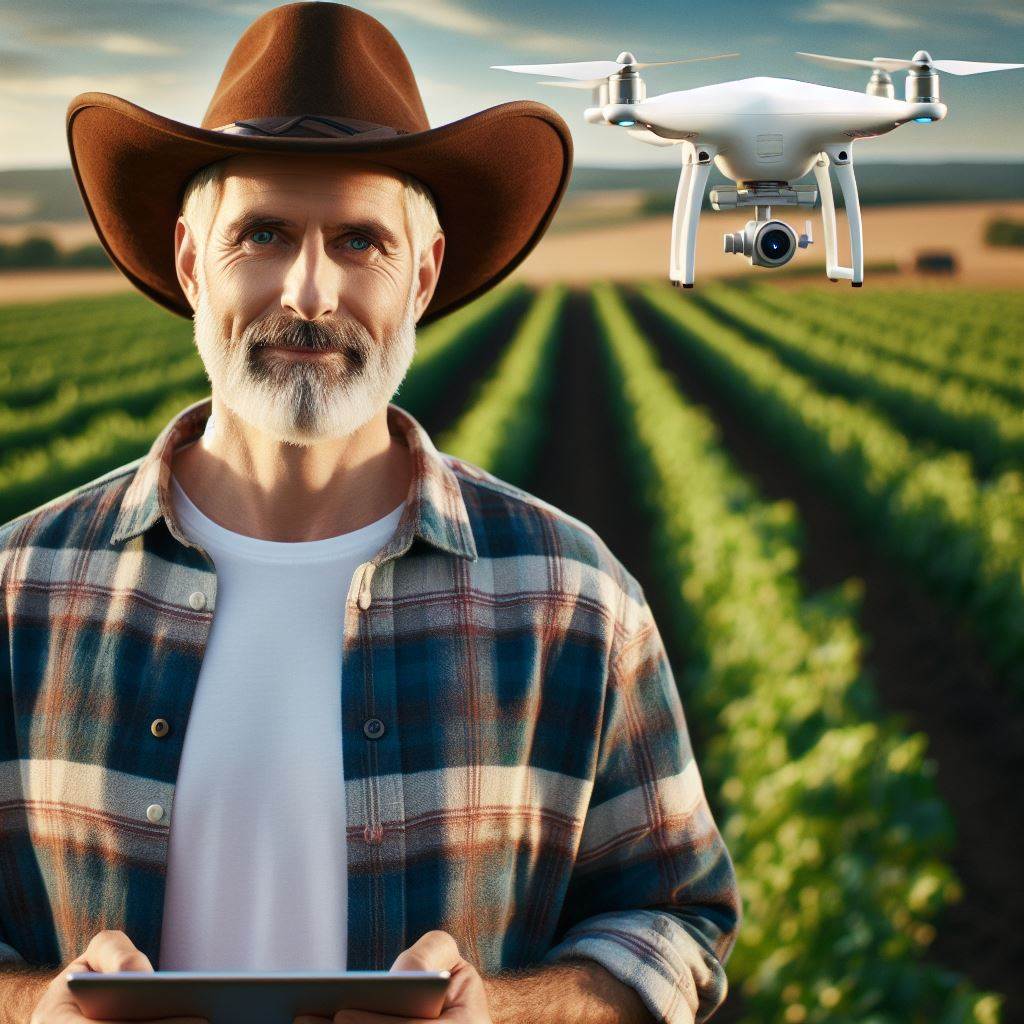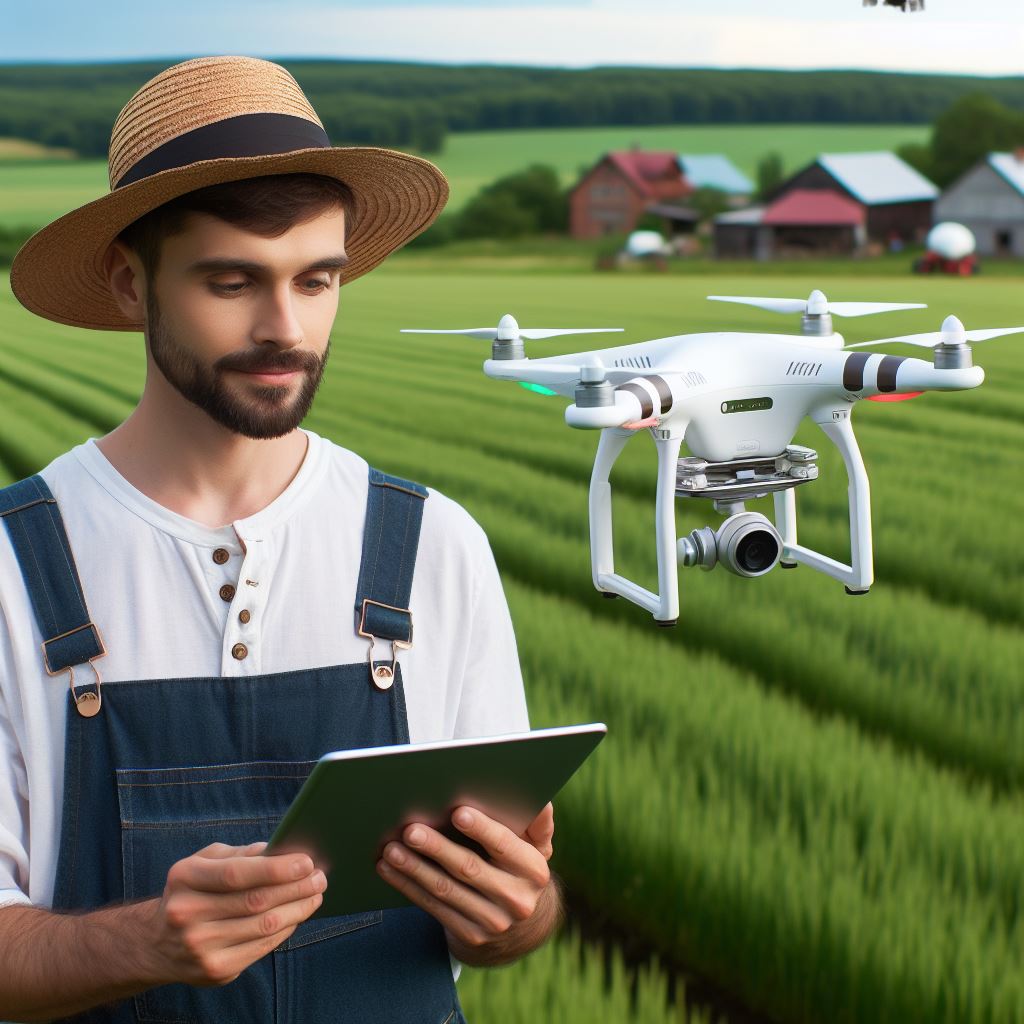Introduction
Climate-smart farming is an agricultural approach that addresses climate change challenges effectively and sustainably.
It is crucial to adopt climate-smart farming practices to ensure long-term sustainable agricultural practices.
The purpose of this blog post is to showcase innovative climate-smart farming practices and their benefits.
Innovative practices for climate-smart farming include:
- Conservation agriculture: This technique minimizes soil disturbance, promotes soil health, and increases water retention.
- Precision agriculture: By using technology, it optimizes the use of resources like water, fertilizers, and pesticides.
- Agroforestry: Integrating trees with crops promotes biodiversity, enhances soil fertility, and provides additional income streams.
- Diversification: Planting diverse crops reduces vulnerability to pests, diseases, and climate-related risks.
- Crop rotation: Alternating crops on the same land improves soil health, reduces pests, and increases yields.
- Integrated pest management: Combining various eco-friendly methods reduces chemical pesticide use, preserving beneficial insects.
- Water management: Implementing efficient irrigation systems minimizes water wastage and improves water availability for crops.
- Climate-smart livestock management: Practices like rotational grazing and livestock waste management reduce greenhouse gas emissions.
Benefits of climate-smart farming innovations include the following:
- Enhanced resilience: Climate-smart farming helps farmers adapt to changing climate patterns and extreme weather events.
- Improved productivity: Innovative practices boost crop yields, improve food security, and increase farmers’ incomes.
- Environmental sustainability: These practices reduce greenhouse gas emissions, protect biodiversity, and conserve natural resources.
- Economic viability: Climate-smart farming practices are financially beneficial in the long run, reducing input costs for farmers.
- Social equity: Climate-smart farming supports rural communities, empowering smallholders and promoting inclusive agricultural development.
In short, adopting climate-smart farming innovations is crucial for sustainable agriculture, ensuring food security, resilience, and environmental protection.
Read: Precision Ag: Revolutionizing Farms
Overview of Climate-Smart Farming
Definition and Concept
Climate-smart farming refers to agricultural practices that are sustainable, resilient, and adaptive to climate change.
Principles and Objectives
- Principles: Conservation, restoration, and enhancement of natural resources, emissions reduction, and sustainable livelihoods.
- Objectives: Enhancing food security, increasing farmers’ resilience, and reducing agriculture-related greenhouse gas emissions.
Benefits of Climate-Smart Farming
- Increased crop yields: Implementing climate-smart practices leads to improved productivity and profitability.
- Enhanced resilience: Climate-smart techniques help farmers withstand extreme weather events and changing climatic conditions.
- Biodiversity conservation: These farming methods promote ecological diversity and preserve habitats for diverse species.
- Water management: Climate-smart farming practices improve water efficiency and minimize risks of water scarcity.
- Soil health improvement: Implementing techniques like cover cropping and agroforestry enhances soil fertility and reduces erosion.
- Carbon sequestration: Climate-smart farming plays a crucial role in capturing and storing carbon dioxide, mitigating climate change.
- Income diversification: By adopting innovative practices, farmers can explore alternate income streams, reducing vulnerability.
- Responsible resource use: Climate-smart farming promotes responsible use of land, water, and other resources.
Climate-smart farming practices offer multiple benefits to farmers, the environment, and society at large.
By implementing these practices, farmers not only improve their productivity and income but also contribute to mitigating climate change, conserving natural resources, and ensuring food security.
Read: Moisture Sensors: Boosting Crop Yields
Innovations in Climate-Smart Farming
Climate-smart farming innovations have revolutionized the agricultural sector, offering sustainable solutions to combat climate change.
These innovations, driven by precision agriculture techniques, sustainable water management, alternative energy sources, soil health management, and agroecological approaches, are transforming the way we grow food while minimizing environmental impacts.
Precision agriculture techniques
Precision agriculture techniques utilize advanced technologies to optimize farming practices and enhance productivity
- Use of sensors and remote sensing technology: The use of sensors and remote sensing technology provides real-time data on soil health, moisture levels, and crop development, enabling farmers to make informed decisions.
- Geographic Information Systems (GIS) and Global Positioning System (GPS): Geographic Information Systems (GIS) and Global Positioning System (GPS) aid in precise mapping and location-specific farming, minimizing resource wastage.
- Variable rate technology for inputs: Variable rate technology allows farmers to optimize input usage based on individual field needs, reducing costs and environmental impacts.
Sustainable water management
Sustainable water management is crucial in climate-smart farming.
Transform Your Agribusiness
Unlock your farm's potential with expert advice tailored to your needs. Get actionable steps that drive real results.
Get Started- Conservation practices like drip irrigation and rainwater harvesting: Conservation practices such as drip irrigation and rainwater harvesting minimize water wastage and ensure efficient water distribution.
- Efficient use of water through soil moisture sensors and smart irrigation systems: Soil moisture sensors and smart irrigation systems help farmers precisely monitor and control water usage, reducing excess irrigation.
- Water recycling and reuse methods: Additionally, water recycling and reuse methods effectively manage water resources, minimizing dependence on freshwater sources.
Alternative energy sources
Alternative energy sources play a vital role in climate-smart farming.
- Integration of solar panels and wind turbines on farms: Integration of solar panels and wind turbines on farms provides renewable energy, reducing reliance on fossil fuels.
- Bioenergy production from crop residues or animal waste: Bioenergy production from crop residues or animal waste offers an additional sustainable energy source.
- Use of energy-efficient machinery and equipment: Furthermore, the use of energy-efficient machinery and equipment decreases energy consumption and lowers carbon emissions.
Soil health management
Soil health management is essential for sustainable agriculture.
- Conservation tillage and cover cropping: Conservation tillage and cover cropping methods reduce soil erosion, improve moisture retention, and enhance soil fertility.
- Nutrient management practices: Effective nutrient management practices, including proper fertilizer application and precision farming techniques, ensure optimum nutrient utilization, reducing nutrient runoff into water bodies.
- Carbon sequestration through agroforestry or enhanced soil organic matter: Carbon sequestration through agroforestry or enhanced soil organic matter helps mitigate climate change by capturing and storing carbon dioxide.
Agroecological approaches
Agroecological approaches promote ecological balance and biodiversity on farms.
- Crop rotation and diversification: Crop rotation and diversification techniques enhance soil health, reduce pest and disease pressure, and increase overall farm resilience.
- Integrated pest management strategies: Integrated pest management strategies focus on biological control methods, minimizing the need for chemical pesticides.
- Restoration of biodiversity through habitat conservation: Restoration of biodiversity through habitat conservation creates a balanced ecosystem that supports natural pest control and pollination services.
In general, climate-smart farming innovations are essential for sustainable agriculture and combating climate change.
Precision agriculture techniques, sustainable water management, alternative energy sources, soil health management, and agroecological approaches offer practical solutions to mitigate environmental impacts while ensuring food security.
Adapting these innovative practices is crucial for creating a resilient and sustainable agricultural system capable of withstanding the challenges posed by climate change.
Read: Irrigation Apps: Tech at Your Fingertips
Case Studies and Success Stories
In recent years, climate-smart farming innovations have gained significant attention and recognition for their potential to address the challenges posed by climate change and create sustainable agricultural systems.
Case studies and success stories highlight the positive impacts of these innovative practices on farm productivity, environmental sustainability, and economic viability.
First Example: Implementation of precision agriculture techniques in a specific region
- Implementation of precision agriculture techniques resulted in improved resource efficiency and crop yield.
- By adopting these techniques, farmers were able to reduce their environmental footprint.
Second Example: Adoption of sustainable water management practices on farms
- Through sustainable water management practices, farms achieved water conservation and resilience to droughts.
- This approach also contributed to the preservation of water quality and aquatic ecosystems.
Third Example: Integration of alternative energy sources for powering farm operations
- The integration of alternative energy sources decreased farms’ dependence on fossil fuels.
- Additionally, this shift led to cost savings and economic benefits for farmers.
As these examples illustrate, climate-smart farming innovations offer practical and effective solutions to address the challenges posed by climate change.
By implementing these practices on a broader scale, agriculture can become more resilient, sustainable, and economically viable in the face of a changing climate.
Governments, organizations, and farmers alike should collaborate to promote and support the wide-scale adoption of these innovative approaches, ensuring a more climate-smart and resilient agricultural sector for future generations.
Read: 2024’s Top Smart Irrigation Systems Reviewed

Challenges and Future Prospects
Barriers to widespread adoption of climate-smart farming innovations
- High upfront costs make it difficult for farmers to invest in climate-smart farming practices.
- Lack of awareness and technical knowledge about climate-smart farming methods hinder adoption.
- Policy and regulatory constraints create barriers and limit the adoption of innovative farming techniques.
Potential solutions and support systems
- Government initiatives and financial incentives can encourage farmers to adopt climate-smart farming practices.
- Education and extension programs can help increase the awareness and technical knowledge of farmers.
- Collaborative efforts and knowledge-sharing platforms can facilitate the adoption of climate-smart farming techniques.
Future advancements and emerging technologies in climate-smart farming
The field of climate-smart farming is continuously evolving, with new advancements and technologies on the horizon.
- Climate-resilient crop varieties are being developed to withstand extreme weather conditions.
- Precision agriculture techniques, such as remote sensing and drones, enable efficient resource management.
- Improved irrigation systems with better water efficiency are being developed for sustainable water management.
- Biological pest control methods and integrated pest management systems reduce the reliance on chemical pesticides.
- Smart farming tools and sensors provide real-time data on soil health, crop growth, and weather conditions.
These advancements hold great promise for the future of climate-smart farming, as they offer more sustainable and efficient ways of agricultural production.
In a nutshell, while climate-smart farming innovations have the potential to address the challenges posed by climate change, there are various barriers to their widespread adoption.
High upfront costs, limited awareness, and policy constraints hinder farmers from embracing these practices.
However, with the support of government initiatives, education programs, and collaboration among stakeholders, the adoption of climate-smart farming can be promoted.
Furthermore, the advancements in technology and emerging techniques offer promising opportunities for the future of climate-smart farming.
By overcoming these challenges and leveraging these prospects, we can work towards achieving a more resilient and sustainable agricultural sector.
Conclusion
Climate-smart farming innovations offer promising solutions to tackle the challenges posed by climate change.
Throughout this blog post, we have explored several key practices that promote resilience, sustainability, and productivity in agriculture.
We discussed the importance of adopting precision agriculture techniques, such as remote sensing and GIS mapping, to optimize resource use and minimize environmental impact.
These technologies allow farmers to better manage their land, water, and fertilizer usage.
Showcase Your Farming Business
Publish your professional farming services profile on our blog for a one-time fee of $200 and reach a dedicated audience of farmers and agribusiness owners.
Publish Your ProfileAnother innovation covered was conservation agriculture, which involves minimal soil disturbance, crop rotation, and cover cropping.
These practices help prevent soil erosion, enhance organic matter, and improve water retention, resulting in improved soil health and reduced greenhouse gas emissions.
Furthermore, the utilization of climate-resilient crop varieties and the implementation of agroforestry systems were highlighted.
By incorporating genetically improved crops and trees into farming systems, farmers can achieve higher yields, diversify income streams, and mitigate climate risks.
It is crucial for farmers and stakeholders to embrace and further develop these climate-smart farming practices.
These innovations offer a pathway towards a more sustainable agricultural future, ensuring food security, livelihoods, and environmental preservation.
Farmers are encouraged to explore and implement these climate-smart farming techniques.
By doing so, they can contribute to building resilient agricultural systems, reduce greenhouse gas emissions, and adapt to the changing climate.
Additionally, stakeholders should support research, training, and policy incentives to facilitate the widespread adoption of these innovative practices.
As we face the challenges of a rapidly changing climate, it is essential to recognize the potential of climate-smart farming in creating a more sustainable and resilient agricultural sector.




